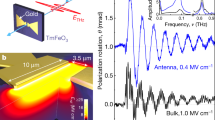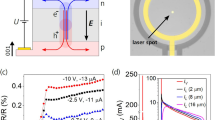Abstract
In spin-based electronics, information is encoded by the spin state of electron bunches1,2,3,4. Processing this information requires the controlled transport of spin angular momentum through a solid5,6, preferably at frequencies reaching the so far unexplored terahertz regime7,8,9. Here, we demonstrate, by experiment and theory, that the temporal shape of femtosecond spin current bursts can be manipulated by using specifically designed magnetic heterostructures. A laser pulse is used to drive spins10,11,12 from a ferromagnetic iron thin film into a non-magnetic cap layer that has either low (ruthenium) or high (gold) electron mobility. The resulting transient spin current is detected by means of an ultrafast, contactless amperemeter13 based on the inverse spin Hall effect14,15, which converts the spin flow into a terahertz electromagnetic pulse. We find that the ruthenium cap layer yields a considerably longer spin current pulse because electrons are injected into ruthenium d states, which have a much lower mobility than gold sp states16. Thus, spin current pulses and the resulting terahertz transients can be shaped by tailoring magnetic heterostructures, which opens the door to engineering high-speed spintronic devices and, potentially, broadband terahertz emitters7,8,9.
This is a preview of subscription content, access via your institution
Access options
Subscribe to this journal
Receive 12 print issues and online access
$259.00 per year
only $21.58 per issue
Buy this article
- Purchase on Springer Link
- Instant access to full article PDF
Prices may be subject to local taxes which are calculated during checkout




Similar content being viewed by others
References
Stöhr, J. & Siegmann, H. C. Magnetism: From Fundamentals to Nanoscale Dynamics (Springer, 2006).
Wolf, S. A. et al. Spintronics: a spin-based electronics vision for the future. Science 294, 1488–1495 (2001).
Jansen, R. Silicon spintronics. Nature Mater. 11, 400–408 (2012).
Bader, S. D. & Parkin, S. S. P. Spintronics. Annu. Rev. Condens. Matter Phys. 1, 71–88 (2010).
Stiles, M. D. & Miltat, J. in Spin Dynamics in Confined Magnetic Structures III (eds Hillebrands, B. & Ounadjela, K.) 225–308 (Springer, 2006).
Bauer, G. E. W., Saitoh, E. & van Wees, B. J. Spin caloritronics. Nature Mater. 11, 391–399 (2012).
Ferguson, B. & Zhang, X-C. Materials for terahertz science and technology. Nature Mater. 1, 26–33 (2002).
Tonouchi, M. Cutting-edge terahertz technology. Nature Photon. 1, 97–105 (2007).
Ganichev, S. D. & Prettl, W. Intense Terahertz Excitation of Semiconductors (Oxford Univ. Press, 2006).
Ruzicka, B. A., Higley, K., Werake, L. K. & Zhao, H. All-optical generation and detection of subpicosecond ac spin-current pulses in GaAs. Phys. Rev. B 78, 045314 (2008).
Melnikov, A. et al. Ultrafast transport of laser-excited spin polarized carriers in Au/Fe/MgO(001). Phys. Rev. Lett. 107, 076601 (2011).
Rudolf, D. et al. Ultrafast magnetization enhancement in metallic multilayers driven by superdiffusive spin current. Nature Commun. 3, 1037 (2012).
Leitenstorfer, A., Hunsche, S., Shah, J., Nuss, M. C. & Knox, W. H. Femtosecond charge transport in polar semiconductors. Phys. Rev. Lett. 82, 5140–5143 (1999).
Valenzuela, S. O. & Tinkham, M. Direct electronic measurement of the spin Hall effect. Nature 442, 176–179 (2006).
Saitoh, E., Ueda, M., Miyajima, H. & Tatara, G. Conversion of spin current into charge current at room temperature: inverse spin-Hall effect. Appl. Phys. Lett. 88, 182509 (2006).
Bonn, M. et al. Ultrafast electron dynamics at metal surfaces: competition between electron–phonon coupling and hot-electron transport. Phys. Rev. B 61, 1001–1005 (2000).
Malinowski, G. et al. Control of speed and efficiency of ultrafast demagnetization by direct transfer of spin angular momentum. Nature Phys. 4, 855–858 (2008).
Walter, M. et al. Seebeck effect in magnetic tunnel junctions. Nature Mater. 10, 742–746 (2011).
Zhukov, V. P., Chulkov, E. V. & Echenique, P. M. Lifetimes and inelastic mean free path of low-energy excited electrons in Fe, Ni, Pt, and Au: ab initio GW+T calculations. Phys. Rev. B 73, 125105 (2006).
Battiato, M., Carva, K. & Oppeneer, P. M. Superdiffusive spin transport as a mechanism of ultrafast demagnetization. Phys. Rev. Lett. 105, 027203 (2010).
Wiese, N. et al. Strong temperature dependence of antiferromagnetic coupling in CoFeB/Ru/CoFeB. Europhys. Lett. 78, 67002 (2007).
Schmidt, A. B. et al. Ultrafast magnon generation in an Fe film on Cu(100). Phys. Rev. Lett. 105, 197401 (2010).
Nagaosa, N., Sinova, J., Onoda, S., MacDonald, A. H. & Ong, N. P. Anomalous Hall effect. Rev. Mod. Phys. 82, 1539–1592 (2010).
Mosendz, O. et al. Quantifying spin Hall angles from spin pumping: experiments and theory. Phys. Rev. Lett. 104, 046601 (2010).
Freimuth, F., Blügel, S. & Mokrousov, Y. Anisotropic spin Hall effect from first principles. Phys. Rev. Lett. 105, 246602 (2010).
Seki, T. et al. Giant spin Hall effect in perpendicularly spin-polarized FePt/Au devices. Nature Mater. 7, 125–129 (2008).
Kirilyuk, A., Kimel, A. V. & Rasing, T. Ultrafast optical manipulation of magnetic order. Rev. Mod. Phys. 82, 2731–2784 (2010).
Beaurepaire, E. et al. Coherent terahertz emission from ferromagnetic films excited by femtosecond laser pulses. Appl. Phys. Lett. 84, 3465–3468 (2004).
Hilton, D. J. et al. Terahertz emission via ultrashort-pulse excitation of magnetic metal films. Opt. Lett. 29, 1805–1807 (2004).
Kanda, N. et al. The vectorial control of magnetization by light. Nature Commun. 2, 362 (2011).
Nastos, F., Newson, R. W., Hübner, J., van Driel, H. M. & Sipe, J. E. Terahertz emission from ultrafast optical orientation of spins in semiconductors: experiment and theory. Phys. Rev. B 77, 195202 (2008).
Watanabe, S., Komine, T., Kai, T. & Shiiki, K. First-principle band calculation of ruthenium for various phases. J. Magn. Magn. Mater. 220, 277–284 (2000).
Gradhand, M. et al. Perfect alloys for spin Hall current-induced magnetization switching. SPIN 2, 1250010 (2012).
Renger, J., Quidant, R. & Novotny, L. Enhanced nonlinear response from metal surfaces. Opt. Express 19, 1777–1785 (2011).
Acknowledgements
The authors thank R.K. Campen, K. Carva, F. Giesen, A. Hoffmann and A. Melnikov for stimulating discussions. T.K., S.M. and M.W. acknowledge funding by the EU-FP7 project CRONOS (grant no. 280879). M.M., G.E., F.F., Y.M. and S.B. thank the German Science Foundation for financial support through SFB 602 and SPP 1538 (SpinCaT). F.F. and Y.M. acknowledge funding by the HGF-YIG programme VH-NG-513 and computer time at the Jülich Supercomputing Centre. M.B., P.M. and P.M.O. acknowledge support from the Swedish Research Council, EU-FP7 projects Fantomas (grant no. 214810) and FemtoSpin (grant no. 281043), and the Swedish National Infrastructure for Computing (SNIC).
Author information
Authors and Affiliations
Contributions
T.K., M.W., I.R. and M.M. initiated the project. T.K., J.N. and S.M. designed the experiment, performed the terahertz measurements and analysed the data. G.E., V.Z., I.R. and M.M. fabricated and characterized the samples. M.B., P.M. and P.M.O. conducted the spin transport calculations. F.F. performed the spin Hall conductivity calculations. T.K., M.B., F.F., Y.M., M.W., I.R., P.M.O. and M.M. co-wrote the paper. All authors discussed the results and commented on the manuscript.
Corresponding author
Ethics declarations
Competing interests
The authors declare no competing financial interests.
Supplementary information
Rights and permissions
About this article
Cite this article
Kampfrath, T., Battiato, M., Maldonado, P. et al. Terahertz spin current pulses controlled by magnetic heterostructures. Nature Nanotech 8, 256–260 (2013). https://doi.org/10.1038/nnano.2013.43
Received:
Accepted:
Published:
Issue Date:
DOI: https://doi.org/10.1038/nnano.2013.43
This article is cited by
-
Light-driven nanoscale vectorial currents
Nature (2024)
-
Spin current driven by ultrafast magnetization of FeRh
Nature Communications (2023)
-
Efficient ultrafast field-driven spin current generation for spintronic terahertz frequency conversion
Nature Communications (2023)
-
Ultrafast THz probing of nonlocal orbital current in transverse multilayer metallic heterostructures
Nature Communications (2023)
-
Enhancement of spintronic terahertz emission enabled by increasing Hall angle and interfacial skew scattering
Communications Physics (2023)



